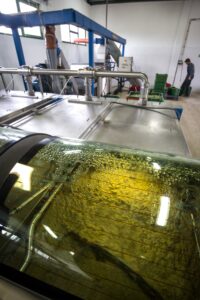Quality Traits of Olive Oil

This post is also available in:
This post is also available in:
![]() Français (French)
Français (French) ![]() Deutsch (German)
Deutsch (German) ![]() Türkçe (Turkish)
Türkçe (Turkish) ![]() Ελληνικά (Greek)
Ελληνικά (Greek)
As mentioned in the international literature, the quality criteria of olive oil are its acidity, oxidation, color and aroma and taste.
- Acidity
Acidity is expressed in g of oleic acid per 100 g of olive oil and based on that olive oil is distinguished as suitable for human consumption or for industrial use. The hydrolysis of the triglycerides, the result of which is the increase in the acidity of the olive oil, takes place mainly before its extraction from the fruit. Thus, the acidity depends mainly on the quality of the fruit and changes only a bit after receiving the olive oil from it. This slight increase is mainly due to the hydrolytic enzymes and moisture present in the sediment. Extra virgin olive oil is defined as that whose acidity does not exceed 0.8%.
In the graph below, it can be seen that the more the fruit ripens (horizontal axis), the more the acidity increases (vertical axis).

- Oxidation
Oxidation is determined based on the number of peroxides and the absorption in the UV spectrum.
Number of peroxides: In virgin olive oil their number must be less than or equal to 20. A high number of peroxides indicates that the olive oil has undergone oxidative or other changes and is associated with a reduction in its shelf life.

Absorption in the UV spectrum: This value is measured using the constants K232 (it should be below 2.50 in extra virgin olive oil) and K270 (it should be below 0.22 in extra virgin olive oil). These measurements are used both to determine oxidation and to detect adulteration.
- Colour
The color of the olive oil is mainly determined by the pigments that prevail in the fruit when it is harvested. Thus, olive oil is green when the olive fruit is unripe, i.e. at the beginning of the harvest season, as the chlorophylls prevail at that time. Gradually the color changes to yellow, since the concentration of carotenes increases and finally to gray, when it is an overripe fruit.
When the malaxation of the olive paste is prolonged, a greater amount of chlorophyll is released, resulting in the olive oil acquiring a more intense green color.
- Aroma, taste
The organoleptic characteristics are the most important part of the quality assessment of an olive oil. Based on these, the division is made into “agourelaia” (bitter taste), bitter olive oils (large amounts of leaves), fruity (normally ripened fruit), olive oils with a good taste (distinctive and pleasant), and defective ones (musty, rancid taste, etc.).
References
Balatsouras, G.D., The table olive, published by Balatsouras G.D., Athens, 1995








































































